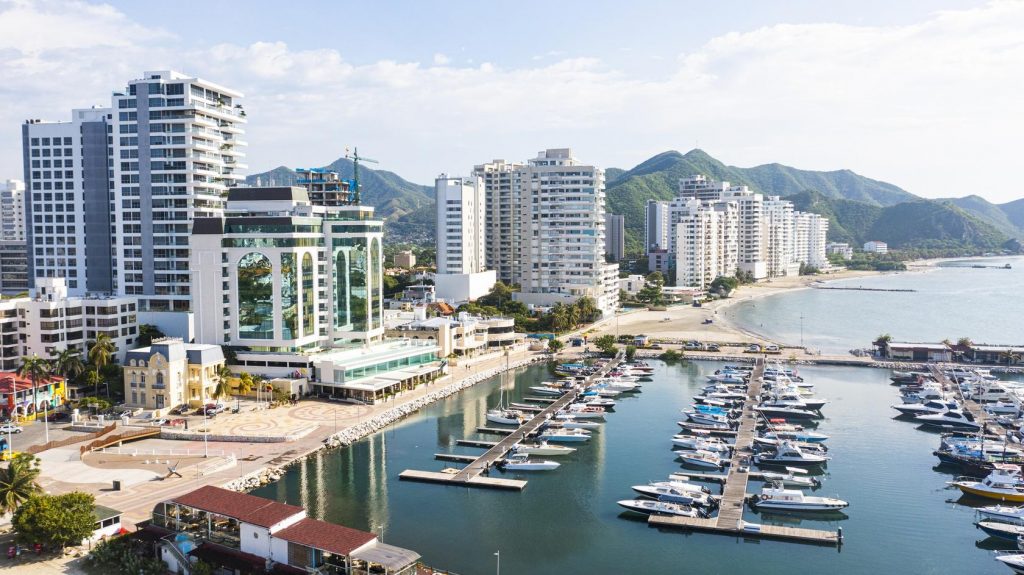I’ll let you in on a little secret: one of the coolest destinations in the Caribbean isn’t on an island at all. Located on the Caribbean coast of Colombia, the colorful, colonial-era city of Cartagena transformed tourism in the region, slowly at first and then all at once. It’s a destination that seamlessly mixes history, heritage, and beachy beauty in a way few others in the Caribbean can.
Cartagena’s transformation over the past fifteen years has been the talk of Caribbean tourism, but ask a local where they’re headed on a beach vacation, and you’ll hear one answer: Santa Marta.
Just a few hours up the coast from Cartagena, Santa Marta is a beachfront gem that handily proves that Colombia’s self-styled moniker as “the Country of Beauty” is easily earned. Celebrating its 500th birthday this summer, Santa Marta finally seems poised to emerge from the shadow of bigger, buzzier Cartagena, once and for all.
Bienvenidos a Santa Marta
The sweet, seaside city of Santa Marta is only the third-largest city on Colombia’s Caribbean coast; it doesn’t even crack the top ten cities in the country in terms of size. Yet as the oldest continuously inhabited European settlement in Colombia, Santa Marta holds an immensity of historic and cultural influence that has shaped the nation.
Out of every city in Colombia, Santa Marta shines as the destination to show the most rapidly growing tourism industry, during a year when Colombia hit a record-breaking 6.8 million visitors. Recent statistics from the nation’s Ministry of Commerce, Industry and Tourism show that in February, Santa Marta showed the most rapid growth in national arrivals of any city in Colombia, welcoming 26.1% more visitors than it did the previous year. In March, it welcomed 19.9% more visitors.
Santa Marta also showed a 22.7% increase in international arrivals over the previous year, third among all Colombian cities in terms of the most rapid growth from abroad. This is even more remarkable considering the city’s flight capacity. Currently, Santa Marta receives just three international direct flights a week, all via Copa Airlines’ Hub of the Americas in Panama City, Panama.
Destination Diversity
What’s bringing so many visitors to Santa Marta these days? Perhaps the better question is: what isn’t? “[Santa Marta] is the oldest city in the country and one of the few places in the world where you can go from the Caribbean Sea to snow-capped mountains in a single day,” says Tomas Ford, General Manager of Santa Marta Marriott Resort Playa Dormida, one of the most beloved beachside places to stay in the city. “Its blend of history, culture, biodiversity, and coastal charm offers travelers an experience that feels authentic,” he says.
“From our experience…Santa Marta attracts a rich mix: foodies looking for Caribbean flavors, families seeking comfort and fun, beach lovers chasing sunsets, and adventure seekers drawn to jungle treks and diving,” says Ford. Like Cartagena, it’s a destination that has a unique mix of vibrant city life and coastal relaxation. But in Santa Marta, the beaches are even better.
Well-heeled travelers familiar with the Caribbean coast of Colombia will tell you that while Cartagena is waterfront, its beaches leave much to be desired. Santa Marta, on the other hand, is home to Tayrona National Park, known for having the best beaches in Colombia, if not in all of South America.
Here, the golden, palm-fringed sands rival those found on any Caribbean island neighbor. Even better, beaches sit within a strictly protected territory that limits daily visitor numbers and prevents overtourism, making them almost totally undeveloped and untouched. It’s hard to find a more paradisiacal playa anywhere these days.
“We’ve also noticed an increasing number of travelers looking for meaningful, nature-connected experiences, and this region delivers on all fronts,” says Ford. Hidden within the mountains that hem in Santa Marta is a geological and ecological richness that Cartagena just can’t compete with.
Visitors can take excursions into the jungle to encounter everything from endemic flora and fauna to hidden waterfalls with swimming holes, but the biggest reward comes from the four-day trek to Ciudad Perdida, a “lost” city known only to the indigenous communities that cared for it until the 1970s. Some compare the terraced ruins to Machu Picchu, but with only a few dozen visitors reaching this architectural marvel every day via trekking routes loving cared for and protected by indigenous communities, the experience of a visit couldn’t be further from that at the overrun city of the Incas.
The Next Half Millennium
2025 has already been a banner year for tourism in Santa Marta, but as the city celebrates its 500th anniversary, there’s even more reason to visit now. “Expect cultural events, traditional music, local gastronomy, and storytelling that honors the city’s legacy,” says Ford. “It’s the perfect time to enjoy signature flavors like bollos, arepas de huevo, and fresh seafood while walking streets that have seen half a millennium of history.”
Celebrations are ongoing in the city through the end of the month, though the festive spirit of the city feels likely to linger the rest of the year.
There’s still much to be done to continue to strengthen Santa Marta as a Caribbean destination with international appeal. The city’s airport still can’t hold a candle to Cartagena when it comes to receiving direct international flights, despite the numerous flights it receives daily from Colombian destinations like Bogotá, Medellín and Cali.
Only time will tell if Santa Marta is ever able to reach the level of buzz of nearby Cartagena. However, for many visitors, it’s Santa Marta’s serenity, combined with its untouched, unchanged beaches, bays, and natural beauty that makes it so appealing in the first place, and that’s something they hope will never change.

